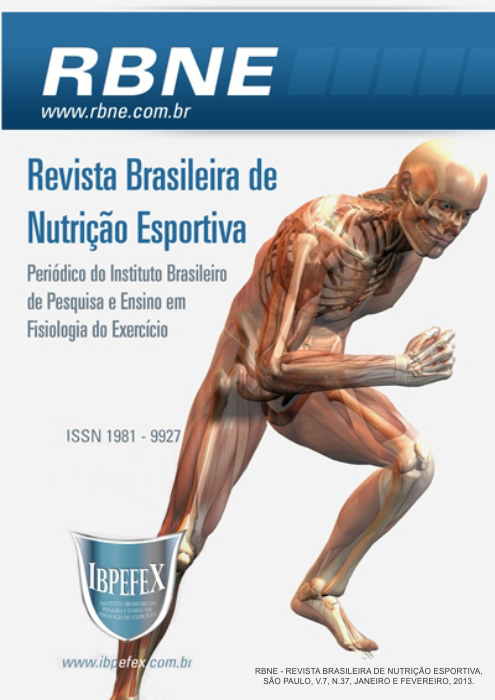Prevalence of muscle dysmorphia in women attending academy
Abstract
Dissatisfaction with its own image seems to be a common occurrence on general population. People with low self-esteem and difficulties in interpersonal relationships may frequently reject or accept the suffering with their own body image and, in some cases; this phenomenon may be described as muscle dysmorphia or, as also called, vigorexia. The dependence of women self-esteem upon their appearance make them more vulnerable to negative body image, the literature presents most of the studies with male individuals and thus, theinterest in assessing the prevalence of vigorexia signs and symptoms in women. Thirty-seven women with mean age of about 29,05±9,237, who practitioner physical activities in two academies in the city of Santa Maria/RS were interviewed. These women responded the “Adonis Complex Questionnaire” which consists in understanding the way image concerns may affect the population daily-life. This questionnaire is a set of 13 questions (A, B, C), with scores that give the raw index showing the gravity of body image concerns. The results demonstrated that the interviewed women have a concern about their body image but, it does not affect their daily-life being considered a female vanity. The educational level of the interviewed was complete higher education (35,1% n= 13), bodybuilding practitioners (45,9% n=17) from which 37,8% n=14 reported that the reason for the practice was weight loss and muscle toning. The statistical analysis was performed using the software SPSS version 18.0. It is possible to conclude that women pursue the thinness ideal while men seek to be stronger and larger.
References
-Andrade, B. P.; Stella, S. G. Utilização de suplementos alimentares por praticantes de musculação em academias de Ribeirão Preto, SP. EFDeportes.com, Revista Digital. Buenos Aires. Vol. 15. Núm.148. 2010.
-Araújo, A. C. M.; Soares, Y. N. G. Perfil de utilização de repositores protéicos nas academias de Belém, Pará. Rev. Nutr. Vol. 12. Núm. 1. p. 5-19. 1999.
-Caparros, D. R.; e colaboradores. Ingestão protéica de praticantes de musculação de uma academia do município de Santo André. EFDeportes.com, Revista Digital. Buenos Aires. Núm.132. p. 13-19. 2009.
-Carvalho, J. R.; Hirschbruch, M. D. Consumo de suplementos nutricionais por frequentadores de uma academia de ginástica de São Paulo. In: I Prêmio Maria Lúcia Cavalcanti. Anais. São Paulo: Conselho Regional de Nutricionistas, 3a.região, tese, 2000.
-Carvalho, T. Modificações dietéticas, reposição hídrica, suplementos alimentares e drogas: comprovação de ação ergogênica e potenciais riscos para a saúde. Rev. Bras. Med. Esporte. Vol.9. Núm. 2. p. 19-24. 2003.
-Caspersen, C. J.; Powell, K. E. & Christenson, G. M. Physical activity, exercise and physical fitness: definitions and distinctions for health-related research. Public Health Reports. Vol. 100. Núm. 2. p.126-131. 1985.
-Filardo, R. D.; Leite, N. Perfil dos indivíduos que iniciam programas de exercícios em academias, quanto à composição corporal e aos objetivos em relação a faixa e sexo. Rev. Bras. Med. Esporte. Vol. 7. Núm. 2. p. 57-61. 2001.
-Gomes, G. S. e colaboradores. Caracterização do consumo de suplementos nutricionais em praticantes de atividade física em academias. Medicina. Ribeirão Preto. Vol. 41. Núm. 3. p. 327-331. 2008.
-Hirschbruch, M. D.; Carvalho, J. R. Nutrição esportiva: uma visão prática. A nutrição em academias -aspectos práticos. São Paulo: Manole, p. 123-158. 2002.
-Hirschbruch, M. D.; Fisberg, M.; Mochikuzi, L. Consumo de suplementos por jovens frequentadores de academias de ginástica em São Paulo. Rev. Bras. Med. Esporte. Vol.14. Núm. 6. p. 539-543. 2008.
-Iriart, J. A. B.; Chaves, J.C.; Orleans, R. G. Culto ao corpo e uso de anabolizantes entre praticantes de musculação. Cad. Saúde Pública. São Paulo. Vol. 25. Núm. 4. p. 773-782. 2009.
-Maestá, N.;e colaboradores. Efeito da oferta dietética de proteína sobre o ganho muscular, balanço nitrogenado, e cinética da 15-N-Glicina de atletas em treinamento de musculação. Rev. Bras. Med. Esporte. Vol.14. Núm. 3. p. 215-220. 2008.
-Pamplona, A. P.; Kazapi, I. A. Avaliação dietética de praticantes de atividade física em diferentes modalidades esportivas: um estudo comparativo. Revista Nutrição em pauta. Vol.14. Núm. 5. p. 61-66. 2004.
-Pereira, R. F.; Lajolo, F. M.; Hirschbruch, M. D. Consumo de Suplementos por alunos de academias de ginástica em São Paulo. Rev. Nutr. Vol.16. Núm. 3. p. 539-543. 2003.
-Rocha, L. P.; Pereira, M. V. L. Consumo de suplementos nutricionais por praticantes de exercícios físicos em academias. Rev Nutr. Núm. 11. p. 76-82. 1998.
-Ronsen, O.; Sundgot-Borten, J.; Maehum, S. Supplement use in nutritional habits in Norwegian elite athletes. Scan J Med Sci Sports. Vol. 9. p. 28-35. 1999.
-Theodoro, H.; Ricalde, S.R.; Amaro, F. S. Avaliação nutricional e autopercepção corporal de praticantes de musculação em academias de Caxias do Sul-RS. Rev. Bras. Med. Esporte. Vol. 15. Núm. 4. p. 291-294. 2009.
Authors who publish in this journal agree to the following terms:
- Authors retain the copyright and grant the journal the right of first publication, with work simultaneously licensed under the Creative Commons Attribution License BY-NC which allows the sharing of the work with acknowledgment of the authorship of the work and initial publication in this journal.
- Authors are authorized to enter into additional contracts separately for non-exclusive distribution of the version of the work published in this journal (eg, publishing in institutional repository or book chapter), with acknowledgment of authorship and initial publication in this journal.
- Authors are allowed and encouraged to post and distribute their work online (eg, in institutional repositories or on their personal page) at any point before or during the editorial process, as this can bring about productive change as well as increase impact and impact. citation of published work (See The Effect of Free Access).






